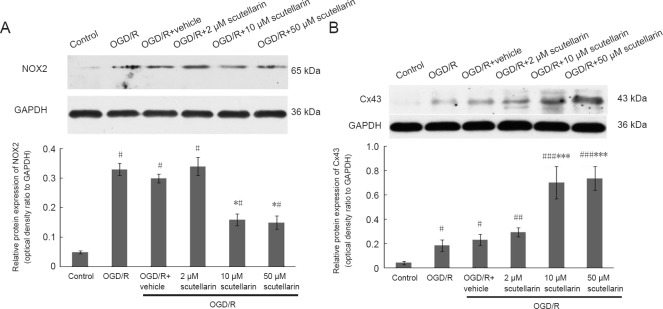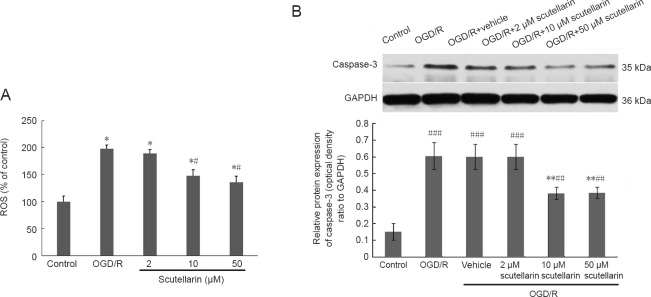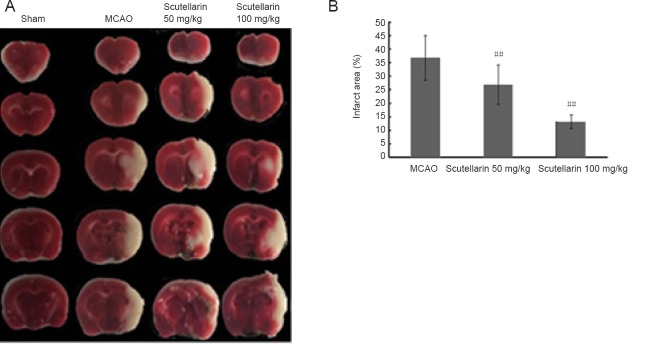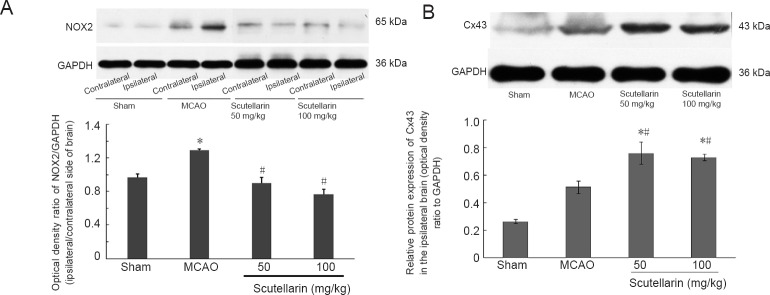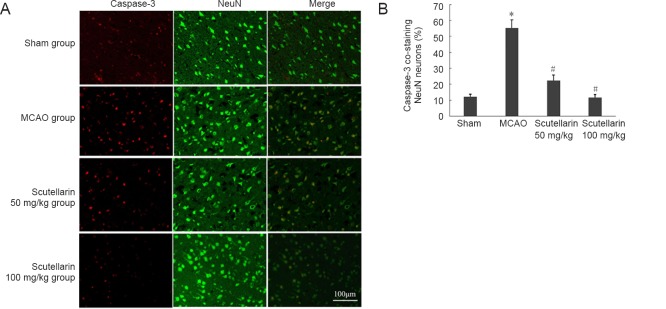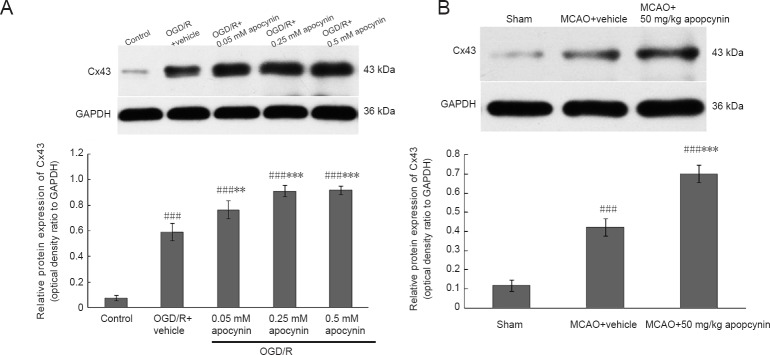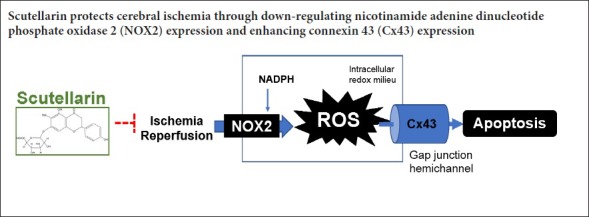
Keywords: nerve regeneration, scutellarin, cerebral ischemic injury, oxygen glucose deprivation/reoxygenation, nicotinamide adenine dinucleotide phosphate oxidase 2, reactive oxygen species, connexin 43, neural regeneration
Abstract
Scutellarin, a bioactive flavone isolated from Scutellaria baicalensis, has anti-inflammatory, anti-neurotoxic, anti-apoptotic and anti-oxidative effects and has been used to treat cardiovascular and cerebrovascular diseases in China. However, the mechanisms by which scutellarin mediates neuroprotection in cerebral ischemia remain unclear. The interaction between scutellarin and nicotinamide adenine dinucleotide phosphate oxidase 2 (NOX2) was assessed by molecular docking study, which showed that scutellarin selectively binds to NOX2 with high affinity. Cultures of primary astrocytes isolated from the cerebral cortex of neonatal Sprague-Dawley rats were pretreated with 2, 10 or 50 μM scutellarin for 30 minutes. The astrocytes were then subjected to oxygen/glucose deprivation by incubation for 2 hours in glucose-free Dulbecco's modified Eagle's medium in a 95% N2/5% CO2 incubator, followed by simulated reperfusion for 22 hours. Cell viability was assessed by cell counting kit-8 assay. Expression levels of NOX2, connexin 43 and caspase-3 were assessed by western blot assay. Reactive oxygen species were measured spectrophotometrically. Pretreatment with 10 or 50 μM scutellarin substantially increased viability, reduced the expression of NOX2 and caspase-3, increased the expression of connexin 43, and diminished the levels of reactive oxygen species in astrocytes subjected to ischemia-reperfusion. We also assessed the effects of scutellarin in vivo in the rat transient middle cerebral artery occlusion model of cerebral ischemia-reperfusion injury. Rats were given intraperitoneal injection of 100 mg/kg scutellarin 2 hours before surgery. The Bederson scale was used to assess neurological deficit, and 2,3,5-triphenyltetrazolium chloride staining was used to measure infarct size. Western blot assay was used to assess expression of NOX2 and connexin 43 in brain tissue. Enzyme-linked immunosorbent assay was used to detect 8-hydroxydeoxyguanosine (8-OHdG), 4-hydroxy-2-nonenal (4-HNE) and 3-nitrotyrosin (3-NT) in brain tissue. Immunofluorescence double staining was used to determine the co-expression of caspase-3 and NeuN. Pretreatment with scutellarin improved the neurological function of rats with focal cerebral ischemia, reduced infarct size, diminished the expression of NOX2, reduced levels of 8-OHdG, 4-HNE and 3-NT, and reduced the number of cells co-expressing caspase-3 and NeuN in the injured brain tissue. Furthermore, we examined the effect of the NOX2 inhibitor apocynin. Apocynin substantially increased connexin 43 expression in vivo and in vitro. Collectively, our findings suggest that scutellarin protects against ischemic injury in vitro and in vivo by downregulating NOX2, upregulating connexin 43, decreasing oxidative damage, and reducing apoptotic cell death.
Introduction
The latest data on cardiovascular disease in China in 2017 show that an estimated 290 million people suffer from cardiovascular disease, including 13 million stroke patients. Stroke is the most common cardiovascular disease and is characterized by high incidence, high recurrence, high disability, high mortality and high economic burden (Donnan et al., 2008). The treatment of stroke is still a global challenge (Goldstein et al., 2006). Among stroke cases, 85% are ischemic, while the remaining 15% are hemorrhagic (Roger et al., 2011). For ischemic stroke, thrombolysis is the only approved effective therapy, but it is limited by risk of hemorrhage and a short therapeutic time window (Wardlaw et al., 1997). Thus, researchers have sought to develop drugs to treat cerebral ischemia through neuroprotection (Schmidt et al., 2013).
Increasing evidence shows that oxidative stress is a major cause of cerebral ischemic injury (Buch et al., 2012; Ma et al., 2013) resulting from increased production of reactive oxygen species (ROS) (Kahles and Brandes, 2013; Brennan-Minnella et al., 2015). Nicotinamide adenine dinucleotide phosphate (NADPH) oxidase 2 (NOX2) is the most important NOX subtype involved in cerebral ischemic injury (Kahles and Brandes, 2013; Brennan-Minnella et al., 2015). Activation of myosin light chain kinase has been found to increase NOX2-mediated oxidation in cerebral ischemia/reperfusion injury (Zhang et al., 2015). Shichinohe et al. (2015) showed that cilostazol ameliorates ischemic tissue damage by inhibiting NOX2-mediated oxidative stress.
Numerous studies have focused on the gene regulatory effects of ROS. However, the effects of ROS on gap junctional intercellular communication are relatively unknown. Gap junctions, the channels that connect the cytoplasm of neighboring cells, such as endothelial cells that form the blood-brain barrier and junctions between astrocytes and neurons, play an important role in central nervous system injury (Li et al., 2015). Connexin 43 (Cx43) is one of the most abundant gap junction proteins in astrocytes (Nagy and Rash, 2000; Contreras et al., 2004). However, the role of Cx43 in astrocytes under ischemic conditions is unclear (Farahani et al., 2005). Many studies have shown that Cx43 protects neurons from cerebral ischemic injury (Schulz et al., 2015; Zhou et al., 2015). For example, selectively knocking out Cx43 in astrocytes results in large infarct volumes in rats subjected to transient middle cerebral artery occlusion (tMCAO) (Nakase et al., 2003). In contrast, other studies suggest that Cx43 worsens neuronal injury caused by cerebral ischemia (Chen et al., 2014a; Gao et al., 2015). In addition, there is a link between Cx43 and NOX in the pathology of some diseases, such as heart failure and diabetic hypogonadism (Xu et al., 2016).
Scutellarin (Figure 1) is a bioactive flavone isolated from Scutellaria baicalensis and has been used clinically to treat cardiocerebrovascular diseases in Asia for many years (Cuzzocrea et al., 2001). Several studies have reported that scutellarin has anti-inflammatory, anti-neurotoxic, anti-apoptotic and anti-oxidative actions (Hong and Liu, 2004; Long et al., 2015; Yuan et al., 2015). However, the mechanisms by which scutellarin mediates neuroprotection against cerebral ischemia remain unknown. In the present study, we investigate the effects of scutellarin on NOX2 and Cx43 expression in in vitro and in vivo models of cerebral ischemic injury.
Figure 1.

Scutellarin selectivity binds to NOX2 with high affinity.
(A) Chemical structure of scutellarin. (B) Three-dimensional docking model of NOX2 and scutellarin.
Materials and Methods
Molecular docking study
Molecular docking is a frequently used method to investigate the interaction between drugs and proteins (Garcia et al., 2014). There are many available docking approaches from which to choose. In this study, automated docking calculations were assessed with AutoDock 4.0 (Molecular Graphics Laboratory, La Jolla, CA, USA), and the three-dimension crystal structure of NOX2 was obtained from the Protein DataBank (PDB ID: 3A1F). The protein crystal structure had water molecules and all other heteroatoms removed.
The docking site chose the active site with low average B-values. Three-dimensional affinity grids were calculated (60 × 50 × 66), centered on the active site with 0.375 Å spacing for each of the atom types [C, A (aromatic C), N, O, S and H (electrostatic)] using AutoGrid 4.0. In this study, the absolute stereochemistry of scutellarin was reported in the literature, and geometry optimizations were performed using the B3LYP density functional with 6-31G (d) basis set in a vacuum using the NWChem Quantum chemistry package (Pacific Northwest National Laboratory, Richland, WA, USA). Lamarckian genetic algorithm was selected for ligand conformational search using the AutoDock program. A 1.5 Å root-mean-square deviation was chosen for final docked conformations.
Culture of primary astrocytes
Primary cultures of astrocytes were prepared as described previously (Boitier et al., 1999). Astrocytes were isolated from the cerebral cortices of 40 specific-pathogen-free 0–2-day Sprague-Dawley rats (Sun Yat-sen University, Guangzhou, China; license No. SCXK2016-0029). The study was approved by the Animal Care and Use Committee of Sun Yat-sen University (approval No. 2016006). Briefly, cortices were harvested, while the meninges and blood vessels were removed. The cerebral cortex was cut into small pieces (1 mm3) and then dissociated with 0.125% trypsin at 37°C for 5 minutes. The reaction was terminated by addition of Dulbecco's modified Eagle's medium F12 (DMEM-F12; Gibco, Grand Island, NY, USA) containing 10% fetal bovine serum (Gibco). After filtering through a 100 μm strainer mesh, the cells were centrifuged at 300 × g for 5 minutes. The supernatants were removed, and the cell pellets were resuspended in complete culture medium. The cells were then seeded into a 100 μg/μL poly-lysine-coated flask at a density of 1 × 105/cm2, and incubated at 37°C in a 5% CO2 incubator. Culture media was replaced after 24 hours and changed every 3 days until the cells reached confluence. A variety of morphologically distinct astrocytes with many long processes and small cell bodies were obtained, and an astrocytic network was established through cellular process connections.
Purity assessment of cultured primary astrocytes
Immunofluorescence labeling for glial fibrillary acidic protein (GFAP) was performed to assess the purity of primary astrocytes, as previously described (Wang et al., 2011; Cheng et al., 2012, 2013). Astrocytes on coated coverslips in 24-well plates were gently washed for 15 minutes with phosphate-buffered saline (PBS; 0.01 M, pH 7.4), three times for 5 minutes each, and fixed with 4% paraformaldehyde for 15 minutes. After rinsing with PBS, astrocytes were permeabilized with 0.3% Triton X-100, treated with 0.1% bovine serum albumin, and then incubated for 30 minutes at room temperature. The cells were thereafter incubated with anti-GFAP antibody (rabbit; 1:400; Cell Signaling Technology, Beverly, MA, USA) at 4°C overnight, and washed with PBS. The astrocytes were then incubated with secondary antibody (TRITC-conjugated anti-rabbit IgG; 1:800; Cell Signaling Technology) at room temperature in the dark for 2 hours and then washed. Hoechst 33258 was used to stain the nuclei. After the final wash, the cells were imaged under a fluorescence microscope (Leica Microsystems GmbH, Wetzlar, Germany). Negative controls lacking primary or secondary antibody were used.
Oxygen/glucose deprivation/reperfusion (OGD/R) and treatment of astrocytes
OGD/R was performed with primary astrocytes in vitro to mimic cerebral ischemic injury (Zhang et al., 2018). In brief, cultured astrocytes were seeded in 6-well or 96-well plates at a density of 2.5 × 104/mL. After 24 hours, the medium was replaced with fresh culture medium without fetal bovine serum for an additional 24 hours. The cells were then pretreated with vehicle (control) or scutellarin (2, 10 or 50 μM; purity 99%; Shanghai Winherb Medical Technology, Shanghai, China) for 30 minutes or the NADPH oxidase inhibitor apocynin (0.05, 0.25 or 0.5 mM; purity 99%; Sigma-Aldrich, St. Louis, MO, USA) for 2 hours (Song et al., 2013a; Lu et al., 2014; Wang et al., 2016b). All drugs were dissolved in saline and were diluted to appropriate concentrations with culture medium before administration. Afterwards, the astrocytes were subjected to OGD/R. Cells were incubated in deoxygenated glucose-free DMEM (Gibco) in a hypoxic incubator containing 95% N2 and 5% CO2 for 2 hours followed by simulated reperfusion (normal culture conditions) for 22 hours. Control cells were incubated in a 5% CO2 incubator for 24 hours.
Evaluation of cell viability by cell counting kit-8 assay
Cell viability was evaluated after 2 and 22 hours of reperfusion using a cell counting kit-8 assay (Dojindo Laboratories, Kumamoto, Japan). All the procedures followed the manufacturer's instructions. After 4 hours of incubation, the viability of astrocytes was assessed at 450 nm optical density (OD) with a SpectraMax M5 plate reader (Molecular Devices, Sunnyvale, CA, USA) using a 96-well plate, and five replicate wells were assessed in each experiment.
Measurement of ROS
Intracellular levels of ROS were detected with 2′,7′-dichlorodihydrofluorescein diacetate (DCFH-DA; Beyotime, Jiangsu, China) according to the manufacturer's instructions. At the end of OGD/R, the medium was replaced with fresh serum-free medium containing 10 μg/mL DCFH-DA. The DCF fluorescence was measured in a microplate reader (PerkinElmer, Waltham, MA, USA) with excitation at 488 nm and emission at 525 nm.
Animal group assignment and scutellarin treatment
A total of 69 adult male specific-pathogen-free Sprague-Dawley rats weighing 250–270 g and 6–8 weeks old were purchased from the Experimental Animal Center of Sun Yat-sen University of China. The rats were bred in a room at 21–25°C and a humidity of 55–65% under a 12-hour dark/light cycle. The rats were allowed free access to food and water.
To investigate the protective effect of scutellarin on cerebral ischemic injury, rats were randomly divided into four groups: sham (sham operation + saline), MCAO (MCAO + saline), low-dose scutellarin (MCAO + 50 mg/kg scutellarin) and high-dose scutellarin (MCAO + 100 mg/kg scutellarin) (n = 15). The rats in each group were given an intraperitoneal injection of scutellarin dissolved in saline at 2 hours before and at 12, 24, 36, 48 and 60 hours after tMCAO.
To assess whether NOX2 regulates Cx43 in the animal model, nine rats were randomly divided into three groups: sham (sham operation + saline), MCAO (MCAO + saline) and MCAO + apocynin (50 mg/kg). Apocynin (50 mg/kg) was injected intraperitoneally 30 minutes before tMCAO (Jing et al., 2015; Chen et al., 2016).
Rats were killed 3 days after MCAO for western blot assay, enzyme-linked immunosorbent assay (ELISA) and immunohistochemical staining. Sham rats received saline intraperitoneally in the same volume and same time points as the MCAO groups, but the MCA was not occluded.
Cerebral ischemic injury model
The tMCAO model was produced as previously described (Guo et al., 2012). Briefly, the rats were anesthetized with gas anesthesia (2% halothane in 70% N2O/30% O2 for induction and 1% halothane in 70% N2O/30% O2 for maintenance). A nylon monofilament (Johnson & Johnson, Brussels, Belgium) coated with impression material (3 M Dental Products, St Paul, MN, USA) was inserted into the right internal carotid artery to block blood flow at the origin of the middle cerebral artery. Regional cerebral blood flow was monitored during surgery. After 2 hours of occlusion, the filament was pulled out to allow reperfusion, and the rats were kept in an intensive care system (ThermoCare Inc., Incline Village, NV, USA) for 4 hours.
Neurologic deficit score
Three days after tMCAO, the neurologic deficit score was assessed by an examiner who was unaware of the treatment protocols. Neurological deficit was evaluated according to a five-point scale established by Bederson et al. (1986), as follows: 0 = no neurological symptoms; 1 = unable to fully extend the front paw on the contralateral side; 2 = circling to the contralateral side; 3 = falling to the contralateral side; 4 = unable to walk spontaneously.
Measurement of infarct size
Cerebral infarct size was measured by 2,3,5-triphenyltetrazolium chloride (TTC) staining 3 days after tMCAO (Pei et al., 2012). Briefly, the rats were decapitated after neurological evaluation, and the brains were removed quickly and then sliced into six uniform coronal sections of 2 mm thickness each. The sections were stained in 2% TTC (Sigma-Aldrich) at room temperature for 15 minutes and then fixed in 10% formaldehyde solution. Normal brain tissue was stained red, while the infarcted areas were pale. The posterior surface of each slice was photographed and analyzed with Sigma Scan Pro5.0 software. Infarct area was calculated as a percentage of the area of the contralateral hemisphere.
Western blot assay for brain tissues and astrocytes
Western blot assay was performed as previously described (Wang et al., 2011). Protein was obtained from tissues from the ischemic hemisphere (ipsilateral side of the brain) and the non-ischemic hemisphere (contralateral side of the brain), from the corresponding areas of sham-operated rats, as well as from astrocytes in each group using a total protein extraction kit (Jiancheng Biological Institute, Nanjing, China). Protein concentrations were determined with a bicinchoninic acid protein assay kit (Jiancheng Biological Institute). Equal amounts of protein were separated by sodium dodecyl sulfate polyacrylamide gel electrophoresis, and transferred onto polyvinylidene fluoride membranes (Pall, Port Washington, NY, USA). All membranes were blocked with 5% non-fat dry milk diluted in Tris-buffered saline containing 0.1% Tween-20 at room temperature for 2 hours and incubated overnight at 4°C with rabbit anti-NOX2 polyclonal antibody (1:1000; Abcam, Cambridge, UK), rabbit anti-Cx43 polyclonal antibody (1:1000; Abcam), rabbit anti-caspase-3 polyclonal antibody (1:1000; Abcam) or mouse anti-rat glyceraldehyde-3-phosphate dehydrogenase (GADPH) monoclonal antibody (1:1000; Boster, Pleasanton, CA, USA). The membranes were then incubated with a horseradish peroxidase-conjugated polyclonal goat anti-rabbit or monoclonal goat anti-mouse secondary antibody (1:3000; Cell Signaling Technology) for 2 hours at 37°C. After washing three times in 0.1% Tween-20 in Tris-buffered saline, immunoreactive bands were detected by a chemiluminescence system (Bio-Rad, Hercules, CA, USA) and analyzed with ImageJ software (National Institutes of Health, Bethesda, MD, USA). Protein expression was normalized against GAPDH. All experiments were performed in triplicate.
ELISA detection of oxidative stress-related protein expression
The ipsilateral brain samples (n = 6 for each group) were weighed and homogenized with PBS. All the procedures followed the manufacturer's instructions. Briefly, the supernatants of the cerebral cortex samples were collected to determine the total protein concentration using the bicinchoninic acid kit (Jiancheng Biological Institute). The levels of 8-hydroxydeoxyguanosine (8-OHdG), 4-hydroxy-2-nonenal (4-HNE) and 3-nitrotyrosin (3-NT) were determined using ELISA assay kits (Cusabio Biotech, Wuhan, China) and were quantified with a microplate reader at 450 nm. The levels of 8-OHdG, 4-HNE and 3-NT were expressed as a percentage of the control group.
Double immunofluorescence labeling of caspase-3 and NeuN
Brains were harvested and paraffin sections were prepared. Following dewaxing, rehydration and incubation with antigen retrieval buffer (pH 8.0), sections were treated with 0.3% Triton X-100 and 2% bovine serum albumin in PBS at room temperature for 30 minutes. For double-labeling, sections were incubated with mouse anti-NeuN antibody (1:500; Cell Signaling Technology) plus rabbit anti-caspase-3 antibody (1:1000; Abcam) for 24 hours at 4°C. Following three rinses with PBS, the sections were incubated with TRITC-conjugated anti-rabbit IgG (1:500; Sigma-Aldrich) and FITC-conjugated anti-mouse IgG (1:200; Sigma-Aldrich) at room temperature for 1 hour in the dark. Finally, the slides were coverslipped in antifade mounting media (Wuhan Goodbio Technology Co., Ltd., China) and examined by fluorescence microcopy (Zeiss, Oberkochen, Germany) by an investigator blinded to the experimental design. Control experiments included absence of the primary or secondary antibody. The sham group served as a negative control.
Statistical analysis
Statistical analyses were performed using SPSS 16.0 software (SPSS, Chicago, IL, USA). All variables are expressed as the mean ± SD. One-way analysis of variance followed by a Tukey-Kramer multiple comparison test was used to analyze the differences among groups. A value of P < 0.05 was considered statistically significant.
Results
Three-dimensional docking model of scutellarin binding with NOX2
The interaction between scutellarin and NOX2 was examined using automated docking calculations, and the complete view of the three-dimensional docking model of scutellarin with NOX2 is shown in Figure 1. The chemical structure of scutellarin, a well-known flavonoid, is shown in Figure 1A. The three-dimensional structures of NOX2 and scutellarin fit well together (Figure 1B). Scutellarin, as a flavonoid compound, has antioxidant potential. The docking model also indicated that scutellarin selectively binds to NOX2 with a high affinity. Enzymatic assay showed that scutellarin is a NOX2 inhibitor, with a half maximal inhibitory concentration value of 151.6 ± 11.2 mM. These results indicate that NOX2 is a specific target of scutellarin (Figure 1).
Scutellarin protected astrocytes against OGD/R
Purity of cultured astrocytes
A variety of morphologically distinct astrocytes with many long processes and small cell bodies were obtained, and an astrocytic network was established through cellular process connections (Figure 2). Immunofluorescence for GFAP was used to observe the morphology of astrocytes and to assess their purity. All cell nuclei were labeled with 4′,6-diamidino-2-phenylindole (DAPI). The percentage of GFAP-positive cells was greater than 98%.
Figure 2.
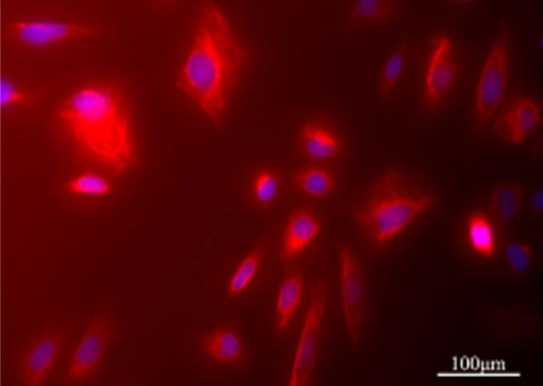
Expression of GFAP in astrocytes detected by immunofluorescence staining.
Cultured astrocytes were labeled with anti-GFAP antibody and counterstained with DAPI nuclear stain. GFAP was localized in the cytoplasm. Scale bar: 100 μm. GFAP: Glial fibrillary acidic protein.
Scutellarin protected astrocytes against OGD/R-induced cytotoxicity
To evaluate the effect of scutellarin pretreatment on OGD/R injury in astrocytes, astrocyte cultures were incubated with culture medium in the presence or absence of scutellarin (2, 10 or 50 μM) for 30 minutes, followed by OGD/R exposure (2-hour period of OGD followed by a 22-hour period of reperfusion). The protective effects of scutellarin against OGD/R-induced astrocyte injury were determined using the cell counting kit-8 assay. As shown in Figure 3, pretreatment with 10 or 50 μM scutellarin significantly improved the viability of astrocytes subjected to OGD/R, compared with the vehicle group (P < 0.05).
Figure 3.
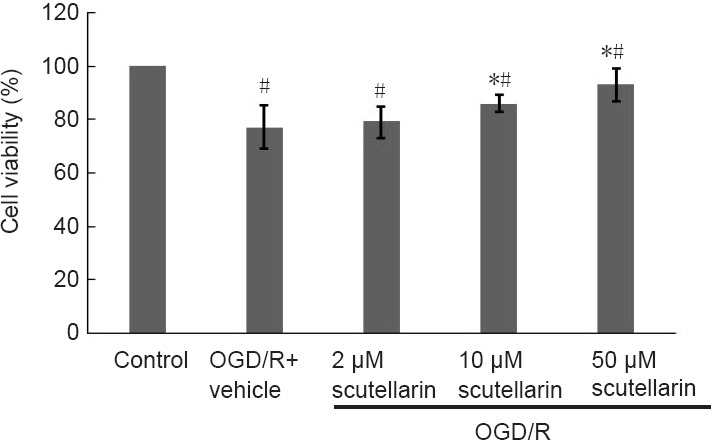
Scutellarin protects astrocytes against oxygen/glucose deprivation/reoxygenation (OGD/R)-induced cytotoxicity (cell counting kit-8 assay).
Cell viability was expressed as the ratio of the optical density at 450 nm to that in the control group. Data are expressed as the mean ± SD (one-way analysis of variance followed by the Tukey-Kramer multiple comparison test). *P < 0.05, vs. OGD/R + vehicle group; #P < 0.05, vs. control group.
The potential cytotoxicity of scutellarin on normal cultured astrocytes was evaluated using the cell counting kit-8 assay. Normal astrocytes were incubated with scutellarin at concentrations of 2, 10 or 50 μM, and viability was compared with that of untreated cells. There was no significant difference in viability among the three concentration groups (data not shown), demonstrating that scutellarin is not cytotoxic to cultured astrocytes. Taken together, these findings show that scutellarin protects against OGD/R-induced cytotoxicity in a dose-dependent manner.
Scutellarin inhibited NOX2 expression in astrocytes subjected to OGD/R
We investigated whether scutellarin treatment affects the expression of NOX2 in OGD/R-exposed astrocytes. The protein levels of NOX2 in astrocytes in the presence or absence of scutellarin (2, 10 or 50 μM) were evaluated by western blot assay. NOX2 expression was significantly greater in OGD/R-exposed astrocytes than in control astrocytes (P < 0.05). Furthermore, the expression of NOX2 in cells treated with 10 or 50 μM scutellarin was significantly decreased compared with the vehicle group. There was no significant difference in NOX2 expression between the 2 μM scutellarin group and the vehicle group (Figure 4A). These results indicate that scutellarin inhibits NOX2 expression in astrocytes subjected to OGD/R injury.
Figure 4.
Scutellarin inhibits NOX2 (A) but enhances Cx43 (B) expression in astrocytes subjected to OGD/R (western blot assay).
Representative immunoblots and semi-quantitative analysis of NOX2 and Cx43 protein levels. Data are expressed as the mean ± SD (n = 3 per group at each time point; one-way analysis of variance followed by the Tukey-Kramer multiple comparison test). *P < 0.05, ***P < 0.001, vs. OGD/R + vehicle group; #P < 0.05, ##P < 0.01, ###P < 0.001, vs. control group. NOX2: Nicotinamide adenine dinucleotide phosphate oxidase 2; Cx43: connexin 43; OGD/R: oxygen/glucose deprivation/reoxygenation; GAPDH: glyceraldehyde-3-phosphate dehydrogenase.
Scutellarin enhanced Cx43 expression in astrocytes subjected to OGD/R
The changes in Cx43 protein expression induced by OGD/R (2 hours of OGD followed by 22 hours of reperfusion) and the effect of scutellarin (2, 10 or 50 μM) on these changes were investigated by western blot assay (Figure 4B). There was an upregulation of Cx43 expression in astrocytes subjected to OGD/R compared with the control group (P < 0.05). Furthermore, Cx43 expression in cells treated with 10 or 50 μM scutellarin was significantly increased compared with the vehicle group. There was no significant difference in Cx43 expression between the 2 μM scutellarin group and the vehicle group. These results demonstrate that scutellarin enhances Cx43 expression in astrocytes subjected to OGD/R-induced injury.
Scutellarin inhibited intracellular accumulation of ROS in astrocytes exposed to OGD/R
Intracellular ROS accumulation caused by OGD exposure was markedly reduced by scutellarin pretreatment. As shown in Figure 5A, compared with normoxic astrocytes, astrocytes subjected to OGD/R (2 hours of OGD followed by 22 hours of reperfusion) showed increased ROS production. Scutellarin (10, 50 μM) markedly reduced this increase in ROS generation, while 2 μM scutellarin had no effect. Scutellarin at 50 μM reduced ROS levels more than at 10 μM. These data indicate that scutellarin plays a role in ROS elimination after OGD/R.
Figure 5.
Scutellarin inhibits the OGD-induced intracellular accumulation of ROS (A) and caspase-3 expression (B) in astrocytes subjected to OGD/R detected using spectrophotometric assay and western blot assay, respectively.
Data are expressed as the mean ± SD (n = 3 per group at each time point; one-way analysis of variance followed by the Tukey-Kramer multiple comparison test). *P < 0.05, **P < 0.01, vs. OGD/R + vehicle group; #P < 0.05, ##P < 0.01, ###P < 0.001, vs. control group. OGD: Oxygen/glucose deprivation; ROS: reactive oxygen species; OGD/R: oxygen/glucose deprivation/reoxygenation; GAPDH: glyceraldehyde-3-phosphate dehydrogenase.
Scutellarin downregulated caspase-3 in astrocytes subjected to OGD/R
Caspase-3 expression in OGD/R-exposed astrocytes and the effect of scutellarin were investigated by western blot assay (Figure 5B). Caspase-3 expression was upregulated in astrocytes subjected to OGD/R compared with the control group (P < 0.001). Furthermore, the expression levels of caspase-3 in cells treated with 10 or 50 μM scutellarin were significantly decreased compared with the vehicle group (P < 0.05). There was no significant difference in expression levels of caspase-3 between the 2 μM scutellarin group and the vehicle group (P > 0.05). These results indicate that scutellarin downregulates caspase-3 in astrocytes subjected to OGD/R, suggesting that scutellarin has an anti-apoptotic effect in these cells.
Protective effect of scutellarin against cerebral ischemic injury in rats
Effects of scutellarin on neurological function and infarct area in rats with cerebral ischemic injury
As shown in Table 1, the sham group did not have any neurological deficits. In comparison, severe neurological deficits were observed in the MCAO group at 1 day. Neurological deficits were significantly improved by scutellarin treatment, whether low- or high-dose, 1 day after reperfusion (P < 0.01, vs. MCAO group). In addition, there was no recovery or change in neurological deficit score in any group 3 days after reperfusion (data not shown). As shown in Figure 6A, B, there was no detectable infarction in the sham group, but a large infarct area was observed in the MCAO group at 3 days. Compared with the MCAO group, infarct area was significantly reduced by scutellarin treatment, whether low- or high-dose, 3 days after reperfusion (P < 0.01, vs. MCAO group).
Table 1.
Effects of scutellarin on neurological deficit score in rats with cerebral ischemic injury 3 days post-injury
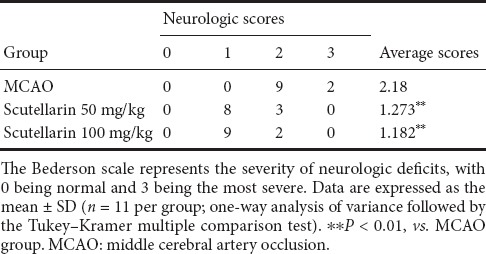
Figure 6.
Effects of scutellarin on infarct area of rats after cerebral ischemic injury.
(A) Representative images of TTC-stained brain sections (the infarcted region appears white). (B) Quantification of infarct area 3 days post-injury (% of contralateral hemisphere). Data are expressed as the mean ± SD (n = 11 per group; one-way analysis of variance followed by the Tukey-Kramer multiple comparison test). ##P < 0.01, vs. MCAO group. TTC: 2,3,5-Triphenyltetrazolium chloride; MCAO: middle cerebral artery occlusion.
Scutellarin inhibited NOX2 expression in the brain of rats with cerebral ischemic injury
As shown in Figure 7A, the effects of scutellarin (50 or 100 mg/kg) on NOX2 expression in the brain 3 days after reperfusion were evaluated by western blot assay. NOX2 expression was similar on the contralateral side of the brain among the various groups, suggesting no effect of drug treatment on expression in this hemisphere. On the ipsilateral side of the brain, the expression levels of NOX2 were greater in the MCAO group than in the sham group (P < 0.05). NOX2 expression in the ipsilateral hemisphere was lower in rats treated with scutellarin (50 and 100 mg/kg) compared with the MCAO group (P < 0.05).
Figure 7.
Scutellarin inhibited NOX2 but enhanced Cx43 expression in the ipsilateral hemisphere of rats with cerebral ischemic injury 3 days after reperfusion (western blot assay).
Representative immunoblots and semi-quantitative analysis of NOX2 (A) and Cx43 (B) protein levels. Data are expressed as the mean ± SD (n = 3 per group; one-way analysis of variance followed by the Tukey-Kramer multiple comparison test). #P < 0.05, vs. MCAO group; *P < 0.05, vs. sham group. NOX2: Nicotinamide adenine dinucleotide phosphate oxidase 2; Cx43: connexin 43; MCAO: middle cerebral artery occlusion; GAPDH: glyceraldehyde-3-phosphate dehydrogenase.
Scutellarin enhanced Cx43 expression in the brain of rats with cerebral ischemia/reperfusion injury
Western blot assay was used to examine the effect of scutellarin (50 or 100 mg/kg) on Cx43 protein levels in the ipsilateral side of the brain. Cerebral ischemia/reperfusion induced a robust increase in Cx43 expression at 3 days (P < 0.05). Cx43 expression was markedly greater in the scutellarin 50 and 100 mg/kg groups than in the MCAO group at 3 days (P < 0.05; Figure 7B).
Scutellarin reduces 8-OHdG, 4-HNE and 3-NT levels after cerebral ischemic injury
Oxidative damage to DNA was assessed by measuring 8-OHdG levels. Lipid peroxidation was assessed by measuring 4-HNE levels. Protein oxidative damage was evaluated by quantifying 3-NT levels. The levels of 8-OHdG, 4-HNE and 3-NT were higher in the MCAO group than in the sham group 3 days after reperfusion. Scutellarin markedly suppressed this ischemic injury-induced increase in the levels of these three indicators (Figure 8).
Figure 8.
Scutellarin reduces the increase in the levels of 8-OHdG (A), 4-HNE (B) and 3-NT (C) induced by cerebral ischemic injury (enzyme-linked immunosorbent assay).
Data are expressed as the mean ± SD (n = 6 per group; one-way analysis of variance followed by the Tukey-Kramer multiple comparison test). #P < 0.05, vs. MCAO group; *P < 0.05, vs. sham group. 8-OHdG: 8-Hydroxydeoxyguanosine; 4-HNE: 4-hydroxy-2-nonenal; 3-NT: 3-nitrotyrosin; MCAO: middle cerebral artery occlusion.
Scutellarin downregulated caspase-3 in neurons in the ischemic penumbra
Immunofluorescence double labeling for caspase-3 and NeuN was carried out to detect apoptosis in neurons in the penumbra after tMCAO injury and to evaluate the effect of scutellarin. Immunostaining showed that capsase-3 was localized in the nuclei of apoptotic cells, while NeuN had a cytoplasmic and perinuclear localization in mature neurons (Figure 9). Cells double-labeled for caspase-3 and NeuN in the penumbra were more numerous in the MCAO group compared with the sham group (P < 0.05). Caspase-3 expression was significantly decreased in the scutellarin (50 and 100 mg/kg) treatment groups compared with the MCAO group (P < 0.05). There was no significant difference in caspase-3/NeuN-double labeling between the scutellarin group and the sham group (P > 0.05). These findings indicate that scutellarin protects against neuronal apoptosis in the penumbra region after tMCAO injury (Figure 9).
Figure 9.
Scutellarin downregulated caspase-3 in the penumbra after cerebral ischemic injury.
(A) Immunofluorescence double-labeling for caspase-3 and NeuN: Capsase-3 is localized in the nuclei of apoptotic cells. NeuN is localized in the cytoplasm and perinuclear region of mature neurons. Scale bar: 100 μm. (B) Percentage of caspase-3+/NeuN+ cells in the penumbra region. Data are expressed as the mean ± SD (n = 3 per group; one-way analysis of variance followed by the Tukey-Kramer multiple comparison test). #P < 0.05, vs. MCAO group; *P < 0.05, vs. sham group. MCAO: Middle cerebral artery occlusion.
Treatment with apocynin increased Cx43 protein expression in OGD/R-exposed astrocytes and cerebral ischemic rats
Cx43 protein expression in the presence or absence of apocynin (0.05, 0.25, 0.5 mM) in OGD-exposed astrocytes 22 hours after reperfusion was evaluated by western blot assay. Cx43 expression in OGD/R-exposed astrocytes was significantly greater than that in the control group (P < 0.001). Furthermore, the expression levels of Cx43 in cells treated with 0.05, 0.25 or 0.5 mM apocynin were significantly increased compared with the vehicle group (Figure 10A).
Figure 10.
Apocynin markedly increased Cx43 protein expression in OGD-exposed astrocytes and in rats with cerebral ischemia/reperfusion injury (western blot assay).
Representative immunoblots and semi-quantitative analysis of Cx43 protein levels (A, B). Data are expressed as the mean ± SD (n = 3 per group; one-way analysis of variance followed by the Tukey-Kramer multiple comparison test). **P < 0.01, ***P < 0.001, vs. OGD/R + vehicle/MCAO + vehicle group; ###P < 0.001, vs. control/sham group. Cx43: Connexin 43; OGD: oxygen/glucose deprivation; OGD/R: oxygen/glucose deprivation/reoxygenation; MCAO: middle cerebral artery occlusion; GAPDH: glyceraldehyde-3-phosphate dehydrogenase.
The effect of apocynin (50 mg/kg) treatment on Cx43 expression 3 days after reperfusion in vivo was evaluated by western blot assay. NOX2 expression in the ipsilateral hemisphere was greater in the MCAO group than in the sham group (P < 0.001). Cx43 expression was greater in rats treated with apocynin than in the MCAO group (P < 0.001; Figure 10B). These results suggest that Cx43 expression is regulated by NOX2 in astrocytes and in the brain of rats exposed to ischemic injury.
Discussion
In the present study, molecular docking study showed that scutellarin and NOX2 are effectively docked with a good fit at the active site. Scutellarin decreased the neurological deficit score, infarct area, apoptosis and ROS levels following ischemic injury in a dose-dependent manner. These effects of scutellarin were associated with the downregulation of NOX2 and the upregulation of Cx43 in the brain in vivo and in astrocytes in vitro. Treatment with apocynin markedly increased Cx43 expression both the in vivo and in vitro models, suggesting that scutellarin has a potent NOX2 inhibiting activity. Given this unique neuroprotective action of scutellarin, it may have therapeutic effectiveness, in combination with thrombolysis, for the treatment of ischemic stroke.
Our results are consistent with previous studies showing that scutellarin is protective in cerebral ischemic injury models in vivo and in vitro (Guo et al., 2011, 2012; Wang et al., 2011, 2016a; Pei et al., 2012; Chai et al., 2013; Fang et al., 2015). In our in vitro experiment, pretreatment with 10 and 50 μM scutellarin significantly improved the viability of OGD/R-exposed astrocytes (85.81 ± 3.20% and 92.75 ± 6.05%, respectively). in vivo, high-dose scutellarin (100 mg/kg) was more effective than low-dose scutellarin (50 mg/kg) at reducing the neurologic deficit and infarct area. Therefore, high-dose scutellarin effectively protects against tMCAO injury. Our finding that the neuroprotective effect of scutellarin is concentration-dependent is in accordance with previously studies (Jiang et al., 2011a, 2011b).
Oxidative stress is one of the main pathogenetic events in cerebral ischemic injury (Manzanero et al., 2013; Feng et al., 2016). Oxidative stress occurs when ROS formation exceeds endogenous antioxidant capacity (Tian et al., 2016). ROS signaling has been shown to be beneficial, and therefore, the timing of anti-oxidant therapy is critical and is likely a key reason for the failure of clinical trials. Moreover, intracellular ROS cause the oxidation of a large number of molecules, such as DNA, lipids and proteins. 8-OHdG, 4-HNE and 3-NT are oxidative stress makers that indicate the degree of oxidative or peroxidative damage to DNA, lipids and proteins, respectively (Chen et al., 2014b; Fan et al., 2016). Scutellarin protects against neuronal injury in rat cerebral ischemia models partly because of its antioxidant property (Tang et al., 2014), which contributes to reducing oxidative stress (Wang et al., 2016c). Here, we found that scutellarin suppresses the increase in oxidative stress makers induced by cerebral ischemia/reperfusion in rats. Our results demonstrate that the neuroprotective effect of scutellarin is through oxidative stress suppression, consistent with a previous study (Guo et al., 2013). At excessive levels, intracellular ROS alter cellular metabolism and the internal environment, ultimately leading to apoptosis (Olmez and Ozyurt, 2012). Among the caspase family members, caspase-3 is a critical mediator of apoptosis (Elmore, 2007). This suggests that the neuroprotective effect of scutellarin involves an anti-apoptotic action.
NOX is a key enzyme producing ROS (such as O2 − and H2O2) in cerebral ischemic injury (Abramov et al., 2007), and NOX activity is among the three distinct processes that generate ROS (Kahles et al., 2007). Several studies strongly indicate an important role of NOX2 in stroke-related oxidative stress injury (Chen et al., 2009). NOX is known to be involved in the pathogenesis of stroke (Tang et al., 2012). In particular, NOX2 plays a critical role in cerebral ischemic injury (Carbone et al., 2015). Several studies show that inhibition of NOX2 expression protects against cerebral ischemic damage (Song et al., 2013b; Shichinohe et al., 2015). Here, we found that cerebral ischemic injury upregulates NOX2, and that scutellarin exerts neuroprotection likely by downregulating the protein. Our results suggest that scutellarin can be used as an inhibitor of NOX2 to treat cerebral ischemic injury.
Gap junctions, an important component in direct cell-to-cell communication, play a central role in the pathogenesis of ischemic brain injury (Deng et al., 2014). Connexin proteins constitute the main components of gap junctions, and Cx43 is one of the most abundant gap junction proteins found in the brain (Contreras et al., 2004; Giaume and Theis, 2010). Although Cx43 is involved in cerebral ischemic injury, the role of the protein in ischemia remains controversial. Nakase et al. (2003) showed that Cx43 protects neurons from cerebral ischemic injury. In contrast, another study showed that inhibition of Cx43 upregulation is neuroprotective in cerebral ischemic injury (Deng et al., 2014). Our previous study showed that upregulation of Cx43 by Tongxinluo administration was neuroprotective against cerebral ischemic injury (Cheng et al., 2017). In our current study, scutellarin upregulated Cx43 expression in rat primary astrocytes and the tMCAO rat model. This suggests that Cx43 has a neuroprotective role in cerebral ischemic injury.
While oxidative stress is associated with stroke, it is unclear how it impacts cell signaling. Oxidative stress affects not only intracellular signaling pathways but also intercellular signaling mechanisms, such as gap junctions. Oxidative stress-dependent interactions between signal transduction pathways and intercellular gap junctional communication has been shown to regulate gene expression (Upham and Trosko, 2009). There is crosstalk between Cx43 and NOX in the pathology of some diseases, such as heart failure and diabetic hypogonadism (Xu et al., 2016). Our present findings show that scutellarin treatment downregulates NOX2 but upregulates Cx43. Furthermore, NOX2 inhibition increased Cx43 expression in both the in vivo and in vitro ischemia models. This novel finding shows that NOX2 regulates Cx43 expression in ischemic injury.
The mechanism by which NOX2 interacts with Cx43 in the cerebral ischemia models is unclear. Cerebral ischemic injury activates NOX enzymes, which not only generate radicals, such as O2− and H2O2, but also induce the production of other ROS. These ROS play important roles in the regulation of cell function, and several of these induce Cx43 expression. The mechanism may involve ROS-regulated activation of several kinases and transcription factors, such as c-Jun N-terminal kinase, mitogen-activated protein kinase and P38. These molecules regulate Cx43 expression (Berthoud and Beyer, 2009). NOX2 is widely distributed in brain tissue. However, cerebral ischemic injury induces not only NOX2 expression but also other NOX proteins such as NOX4. Participation of these molecules in the induction of Cx43 expression is also likely. The roles of these individual proteins need to be investigated by selective gene knockdown.
There are some limitations to this study. For example, the role of Cx43 in central nervous system injury is unclear. A large number of studies demonstrate that the role of Cx43 in cerebral ischemic injury is complex, involving phosphorylated, cytoplasmic and plasma membrane forms of the protein as well as translocation from the cell membrane to the cytoplasm, which could not be examined in this study. Second, we did not investigate whether Cx43 knockdown abolishes the neuroprotective effect of scutellarin in astrocytes. Further studies are needed to tackle these unresolved issues.
Footnotes
Conflicts of interest: None declared.
Financial support: This study was financially supported by the National Natural Science Foundation of China, No. 81303115, 81774042, 81771353; the Natural Science Foundation of Guangdong Province of China, No. S2013040016915; the Science and Technology Program of Guangzhou City of China, No. 201508020050, 201604020003; the Pearl River S&T Nova Program of Guangzhou, the Postdoctoral Foundation of China, No. BBK42913K09, 201003345, BBH429151701; a grant from the Hong Kong Scholar Program, Guangzhou University of TCM 2017 High Level University Construction Program, No. A1-AFD018171Z11096; a grant from the Specialty Program of Guangdong Province Hospital of Traditional Chinese Medicine of China, No. YN2016MJ07, YN2015QN16, YN2015B2025. The funders had no roles in the study design, conduction of experiment, data collection and analysis, decision to publish, or preparation of the manuscript.
Institutional review board statement: The study was approved by the Animal Care and Use Committee at Sun Yat-sen University of China (approval No. 2016006).
Copyright license agreement: The Copyright License Agreement has been signed by all authors before publication.
Data sharing statement: Datasets analyzed during the current study are available from the corresponding author on reasonable request.
Plagiarism check: Checked twice by iThenticate.
Peer review: Externally peer reviewed.
Funding: This study was financially supported by the National Natural Science Foundation of China, No. 81303115, 81774042, 81771353; the Natural Science Foundation of Guangdong Province of China, No. S2013040016915; the Science and Technology Program of Guangzhou City of China, No. 201508020050, 201604020003; the Pearl River S & T Nova Program of Guangzhou, the Postdoctoral Foundation of China, No. BBK42913K09, 201003345, BBH429151701; a grant from the Hong Kong Scholar Program, Guangzhou University of TCM 2017 High Level University Construction Program, No. A1-AFD018171Z11096; a grant from the Specialty Program of Guangdong Province Hospital of Traditional Chinese Medicine of China, No. YN2016MJ07, YN2015QN16, YN2015B2025.
(Copyedited by Patel B, Haase R, Yu J, Li CH, Qiu Y, Song LP, Zhao M)
References
- Abramov AY, Scorziello A, Duchen MR. Three distinct mechanisms generate oxygen free radicals in neurons and contribute to cell death during anoxia and reoxygenation. J Neurosci. 2007;27:1129–1138. doi: 10.1523/JNEUROSCI.4468-06.2007. [DOI] [PMC free article] [PubMed] [Google Scholar]
- Bederson JB, Pitts LH, Tsuji M, Nishimura MC, Davis RL, Bartkowski H. Rat middle cerebral artery occlusion: evaluation of the model and development of a neurologic examination. Stroke. 1986;17:472–476. doi: 10.1161/01.str.17.3.472. [DOI] [PubMed] [Google Scholar]
- Berthoud VM, Beyer EC. Oxidative stress, lens gap junctions, and cataracts. Antioxid Redox Signal. 2009;11:339–353. doi: 10.1089/ars.2008.2119. [DOI] [PMC free article] [PubMed] [Google Scholar]
- Boitier E, Rea R, Duchen MR. Mitochondria exert a negative feedback on the propagation of intracellular Ca2+ waves in rat cortical astrocytes. J Cell Biol. 1999;145:795–808. doi: 10.1083/jcb.145.4.795. [DOI] [PMC free article] [PubMed] [Google Scholar]
- Brennan-Minnella AM, Won SJ, Swanson RA. NADPH oxidase-2: linking glucose, acidosis, and excitotoxicity in stroke. Antioxid Redox Signal. 2015;22:161–174. doi: 10.1089/ars.2013.5767. [DOI] [PMC free article] [PubMed] [Google Scholar]
- Buch P, Patel V, Ranpariya V, Sheth N, Parmar S. Neuroprotective activityof Cymbopogon martinii against cerebral ischemia/reperfusion-induced oxidative stress in rats. J Ethnopharmacol. 2012;142:35–40. doi: 10.1016/j.jep.2012.04.007. [DOI] [PubMed] [Google Scholar]
- Carbone F, Teixeira PC, Braunersreuther V, Mach F, Vuilleumier N, Montecucco F. Pathophysiology and treatments of oxidative injury in ischemic stroke: focus on the phagocytic NADPH oxidase 2. Antioxid Redox Signal. 2015;23:460–489. doi: 10.1089/ars.2013.5778. [DOI] [PMC free article] [PubMed] [Google Scholar]
- Chai L, Guo H, Li H, Wang S, Wang YL, Shi F, Hu LM, Liu Y, Adah D. Scutellarin and caffeic acid ester fraction, active components of Dengzhanxixin injection, upregulate neurotrophins synthesis and release in hypoxia/reoxygenation rat astrocytes. J Ethnopharmacol. 2013;150:100–107. doi: 10.1016/j.jep.2013.08.011. [DOI] [PubMed] [Google Scholar]
- Chen G, Park CK, Xie RG, Berta T, Nedergaard M, Ji RR. Connexin-43 induces chemokine release from spinal cord astrocytes to maintain late-phase neuropathic pain in mice. Brain. 2014a;137:2193–2209. doi: 10.1093/brain/awu140. [DOI] [PMC free article] [PubMed] [Google Scholar]
- Chen H, Song YS, Chan PH. Inhibition of NADPH oxidase is neuroprotective after ischemia-reperfusion. J Cereb Blood Flow Metab. 2009;29:1262–1272. doi: 10.1038/jcbfm.2009.47. [DOI] [PMC free article] [PubMed] [Google Scholar]
- Chen JH, Kuo HC, Lee KF, Tsai TH. Magnolol protects neurons against ischemia injury via the downregulation of p38/MAPK, CHOP and nitrotyrosine. Toxicol Appl Pharmacol. 2014b;279:294–302. doi: 10.1016/j.taap.2014.07.005. [DOI] [PubMed] [Google Scholar]
- Chen XH, Zhou X, Yang XY, Zhou ZB, Lu DH, Tang Y, Ling ZM, Zhou LH, Feng X. Propofol protects against H2O2-induced oxidative injury in differentiated PC12 cells via inhibition of Ca(2+)-dependent NADPH oxidase. Cell Mol Neurobiol. 2016;36:541–551. doi: 10.1007/s10571-015-0235-1. [DOI] [PMC free article] [PubMed] [Google Scholar]
- Cheng X, Liu S, Wang YQ, Li YQ, Fu R, Tang Y, Zheng WH, Zhou LH. Suppression of c-jun influences nNOS expression in differentiated PC12 cells. Mol Med Rep. 2012;6:750–754. doi: 10.3892/mmr.2012.987. [DOI] [PubMed] [Google Scholar]
- Cheng X, Hou Z, Sun J, Huang Y, Wang L, Zhou Z, Zhou LH, Cai Y. Protective effects of Tongxinluo on cerebral ischemia/reperfusion injury related to Connexin 43/Calpain II/Bax/Caspase-3 pathway in rat. J Ethnopharmacol. 2017;198:148–157. doi: 10.1016/j.jep.2017.01.004. [DOI] [PubMed] [Google Scholar]
- Cheng X, Fu R, Gao M, Liu S, Li YQ, Song FH, Bruce IC, Zhou LH, Wu W. Intrathecal application of short interfering RNA knocks down c-jun expression and augments spinal motoneuron death after root avulsion in adult rats. Neuroscience. 2013;241:268–279. doi: 10.1016/j.neuroscience.2013.03.006. [DOI] [PubMed] [Google Scholar]
- Contreras JE, Sanchez HA, Veliz LP, Bukauskas FF, Bennett MV, Sáez JC. Role of connexin-based gap junction channels and hemichannels in ischemia-induced cell death in nervous tissue. Brain Res Brain Res Rev. 2004;47:290–303. doi: 10.1016/j.brainresrev.2004.08.002. [DOI] [PMC free article] [PubMed] [Google Scholar]
- Cuzzocrea S, Riley DP, Caputi AP, Salvemini D. Antioxidant therapy: a new pharmacological approach in shock, inflammation, and ischemia/reperfusion injury. Pharmacol Rev. 2001;53:135–159. [PubMed] [Google Scholar]
- Deng ZH, Liao J, Zhang JY, Liang C, Song CH, Han M, Wang LH, Xue H, Zhang K, Zabeau L, Tavernier J, Yan GT. Inhibition of the connexin 43 elevation may be involved in the neuroprotective activity of leptin against brain ischemic injury. Cell Mol Neurobiol. 2014;34:871–879. doi: 10.1007/s10571-014-0066-5. [DOI] [PMC free article] [PubMed] [Google Scholar]
- Donnan GA, Fisher M, Macleod M, Davis SM. Stroke. Lancet. 2008;371:1612–1623. doi: 10.1016/S0140-6736(08)60694-7. [DOI] [PubMed] [Google Scholar]
- Elmore S. Apoptosis: a review of programmed cell death. Toxicol Pathol. 2007;35:495–516. doi: 10.1080/01926230701320337. [DOI] [PMC free article] [PubMed] [Google Scholar]
- Fan DF, Hu HJ, Sun Q, Lv Y, Ye ZH, Sun XJ, Pan SY. Neuroprotective effects of exogenous methane in a rat model of acute carbon monoxide poisoning. Brain Res. 2016;1633:62–72. doi: 10.1016/j.brainres.2015.12.019. [DOI] [PubMed] [Google Scholar]
- Fang M, Yuan Y, Rangarajan P, Lu J, Wu Y, Wang H, Wu C, Ling EA. Scutellarin regulates microglia-mediated TNC1 astrocytic reaction and astrogliosis in cerebral ischemia in the adult rats. BMC Neurosci. 2015;16:84. doi: 10.1186/s12868-015-0219-6. [DOI] [PMC free article] [PubMed] [Google Scholar]
- Farahani R, Pina-Benabou MH, Kyrozis A, Siddiq A, Barradas PC, Chiu FC, Cavalcante LA, Lai JC, Stanton PK, Rozental R. Alterations in metabolism and gap junction expression may determine the role of astrocytes as “good samaritans” or executioners. Glia. 2005;50:351–361. doi: 10.1002/glia.20213. [DOI] [PubMed] [Google Scholar]
- Feng YH, Zhu ZH, Wu CX, Zhou GP. Effects of electroacupuncture at points selected by orthogonal experiment on the extracellular signal regulated kinase signal pathway in a rat model of cerebral ischenia-reperfusion injury. Zhongguo Zuzhi Gongcheng Yanjiu. 2016;20:5953–5958. [Google Scholar]
- Gao K, Chi Y, Zhang X, Zhang H, Li G, Sun W, Takeda M, Yao J. A novel TXNIP-based mechanism for Cx43-mediated regulation of oxidative drug injury. J Cell Mol Med. 2015;19:2469–2480. doi: 10.1111/jcmm.12641. [DOI] [PMC free article] [PubMed] [Google Scholar]
- Garcia J, Carvalho AT, Dourado DF, Baptista P, de Lourdes Bastos M, Carvalho F. New in silico insights into the inhibition of RNAP II by alpha-amanitin and the protective effect mediated by effective antidotes. J Mol Graph Model. 2014;51:120–127. doi: 10.1016/j.jmgm.2014.05.002. [DOI] [PubMed] [Google Scholar]
- Giaume C, Theis M. Pharmacological and genetic approaches to study connexin-mediated channels in glial cells of the central nervous system. Brain Res Rev. 2010;63:160–176. doi: 10.1016/j.brainresrev.2009.11.005. [DOI] [PubMed] [Google Scholar]
- Goldstein LB, Adams R, Alberts MJ, Appel LJ, Brass LM, Bushnell CD, Culebras A, Degraba TJ, Gorelick PB, Guyton JR, Hart RG, Howard G, Kelly-Hayes M, Nixon JV, Sacco RL American Heart Association/American Stroke Association Stroke Council, Atherosclerotic Peripheral Vascular Disease Interdisciplinary Working Group, Cardiovascular Nursing Council, Clinical Cardiology Council, Nutrition PA, and Metabolism Council. Primary prevention of ischemic stroke: a guideline from the American Heart Association/American Stroke Association Stroke Council: cosponsored by the Atherosclerotic Peripheral Vascular Disease Interdisciplinary Working Group; Cardiovascular Nursing Council; Clinical Cardiology Council; Nutrition, Physical Activity, and Metabolism Council; and the Quality of Care and Outcomes Research Interdisciplinary Working Group: the American Academy of Neurology affirms the value of this guideline. Stroke. 2006;37:1583–1633. doi: 10.1161/01.STR.0000223048.70103.F1. [DOI] [PubMed] [Google Scholar]
- Guo C, Tong L, Xi M, Yang H, Dong H, Wen A. Neuroprotective effect of calycosin on cerebral ischemia and reperfusion injury in rats. J Ethnopharmacol. 2012;144:768–774. doi: 10.1016/j.jep.2012.09.056. [DOI] [PubMed] [Google Scholar]
- Guo H, Hu LM, Wang SX, Wang YL, Shi F, Li H, Liu Y, Kang LY, Gao XM. Neuroprotective effects of scutellarin against hypoxic-ischemic-induced cerebral injury via augmentation of antioxidant defense capacity. Chin J Physiol. 2011;54:399–405. doi: 10.4077/CJP.2011.AMM059. [DOI] [PubMed] [Google Scholar]
- Guo LL, Guan ZZ, Huang Y, Wang YL, Shi JS. The neurotoxicity of beta-amyloid peptide toward rat brain is associated with enhanced oxidative stress, inflammation and apoptosis, all of which can be attenuated by scutellarin. Exp Toxicol Pathol. 2013;65:579–584. doi: 10.1016/j.etp.2012.05.003. [DOI] [PubMed] [Google Scholar]
- Hong H, Liu GQ. Scutellarin attenuates oxidative glutamate toxicity in PC12 cells. Planta Med. 2004;70:427–431. doi: 10.1055/s-2004-818970. [DOI] [PubMed] [Google Scholar]
- Jiang DP, Perelman JM, Kolosov VP, Zhou XD. Effects of scutellarin on MUC5AC mucin production induced by human neutrophil elastase or interleukin 13 on airway epithelial cells. J Korean Med Sci. 2011a;26:778–784. doi: 10.3346/jkms.2011.26.6.778. [DOI] [PMC free article] [PubMed] [Google Scholar]
- Jiang DP, Li Q, Yang J, Perelman JM, Kolosov VP, Zhou XD. Scutellarin attenuates human-neutrophil-elastase-induced mucus production by inhibiting the PKC-ERK signaling pathway in vitro and in vivo. Am J Chin Med. 2011b;39:1193–1206. doi: 10.1142/S0192415X11009494. [DOI] [PubMed] [Google Scholar]
- Jing Y, Wu K, Liu J, Ai Q, Ge P, Dai J, Jiang R, Zhou D, Che Q, Wan J, Zhang L. Aminotriazole alleviates acetaminophen poisoning via downregulating P450 2E1 and suppressing inflammation. PLoS One. 2015;10:e0122781. doi: 10.1371/journal.pone.0122781. [DOI] [PMC free article] [PubMed] [Google Scholar]
- Kahles T, Brandes RP. Which NADPH oxidase isoform is relevant for ischemic stroke? The case for nox 2. Antioxid Redox Signal. 2013;18:1400–1417. doi: 10.1089/ars.2012.4721. [DOI] [PMC free article] [PubMed] [Google Scholar]
- Kahles T, Luedike P, Endres M, Galla HJ, Steinmetz H, Busse R, Neumann-Haefelin T, Brandes RP. NADPH oxidase plays a central role in blood-brain barrier damage in experimental stroke. Stroke. 2007;38:3000–3006. doi: 10.1161/STROKEAHA.107.489765. [DOI] [PubMed] [Google Scholar]
- Li X, Zhao H, Tan X, Kostrzewa RM, Du G, Chen Y, Zhu J, Miao Z, Yu H, Kong J, Xu X. Inhibition of connexin43 improves functional recovery after ischemic brain injury in neonatal rats. Glia. 2015;63:1553–1567. doi: 10.1002/glia.22826. [DOI] [PubMed] [Google Scholar]
- Long L, Wang J, Lu X, Xu Y, Zheng S, Luo C, Li Y. Protective effects of scutellarin on type II diabetes mellitus-induced testicular damages related to reactive oxygen species/Bcl-2/Bax and reactive oxygen species/microcirculation/staving pathway in diabetic rat. Journal of diabetes research. 2015;2015:252530. doi: 10.1155/2015/252530. [DOI] [PMC free article] [PubMed] [Google Scholar]
- Lu XY, Wang HD, Xu JG, Ding K, Li T. NADPH oxidase inhibition improves neurological outcome in experimental traumatic brain injury. Neurochem Int. 2014;69:14–19. doi: 10.1016/j.neuint.2014.02.006. [DOI] [PubMed] [Google Scholar]
- Ma M, Uekawa K, Hasegawa Y, Nakagawa T, Katayama T, Sueta D, Toyama K, Kataoka K, Koibuchi N, Kuratsu J, Kim-Mitsuyama S. Pretreatment with rosuvastatin protects against focal cerebral ischemia/reperfusion injury in rats through attenuation of oxidative stress and inflammation. Brain Res. 2013;1519:87–94. doi: 10.1016/j.brainres.2013.04.040. [DOI] [PubMed] [Google Scholar]
- Manzanero S, Santro T, Arumugam TV. Neuronal oxidative stress in acute ischemic stroke: sources and contribution to cell injury. Neurochem Int. 2013;62:712–718. doi: 10.1016/j.neuint.2012.11.009. [DOI] [PubMed] [Google Scholar]
- Nagy JI, Rash JE. Connexins and gap junctions of astrocytes and oligodendrocytes in the CNS. Brain Res Brain Res Rev. 2000;32:29–44. doi: 10.1016/s0165-0173(99)00066-1. [DOI] [PubMed] [Google Scholar]
- Nakase T, Fushiki S, Naus CC. Astrocytic gap junctions composed of connexin 43 reduce apoptotic neuronal damage in cerebral ischemia. Stroke. 2003;34:1987–1993. doi: 10.1161/01.STR.0000079814.72027.34. [DOI] [PubMed] [Google Scholar]
- Olmez I, Ozyurt H. Reactive oxygen species and ischemic cerebrovascular disease. Neurochem Int. 2012;60:208–212. doi: 10.1016/j.neuint.2011.11.009. [DOI] [PubMed] [Google Scholar]
- Pei H, Su X, Zhao L, Li H, Guo Y, Zhang M, Xin H. Primary study for the therapeutic dose and time window of picroside II in treating cerebral ischemic injury in rats. Int J Mol Sci. 2012;13:2551–2562. doi: 10.3390/ijms13032551. [DOI] [PMC free article] [PubMed] [Google Scholar]
- Roger VL, Go AS, Lloyd-Jones DM, Adams RJ, Berry JD, Brown TM, Carnethon MR, Dai S, de Simone G, Ford ES, Fox CS, Fullerton HJ, Gillespie C, Greenlund KJ, Hailpern SM, Heit JA, Ho PM, Howard VJ, Kissela BM, Kittner SJ, et al. Heart Disease and Stroke Statistics—2011 Update: A Report From the American Heart Association. Circulation. 2011;123:e18–e209. doi: 10.1161/CIR.0b013e3182009701. [DOI] [PMC free article] [PubMed] [Google Scholar]
- Schmidt A, Minnerup J, Kleinschnitz C. Emerging neuroprotective drugs for the treatment of acute ischaemic stroke. Expert Opin Emerg Drugs. 2013;18:109–120. doi: 10.1517/14728214.2013.790363. [DOI] [PubMed] [Google Scholar]
- Schulz R, Gorge PM, Gorbe A, Ferdinandy P, Lampe PD, Leybaert L. Connexin 43 is an emerging therapeutic target in ischemia/reperfusion injury, cardioprotection and neuroprotection. Pharmacol Ther. 2015;153:90–106. doi: 10.1016/j.pharmthera.2015.06.005. [DOI] [PMC free article] [PubMed] [Google Scholar]
- Shichinohe H, Tan C, Abumiya T, Nakayama N, Kazumata K, Hokari M, Houkin K, Kuroda S. Neuroprotective effects of cilostazol are mediated by multiple mechanisms in a mouse model of permanent focal ischemia. Brain Res. 2015;1602:53–61. doi: 10.1016/j.brainres.2015.01.022. [DOI] [PubMed] [Google Scholar]
- Song SX, Gao JL, Wang KJ, Li R, Tian YX, Wei JQ, Cui JZ. Attenuation of brain edema and spatial learning deficits by the inhibition of NADPH oxidase activity using apocynin following diffuse traumatic brain injury in rats. Mol Med Rep. 2013a;7:327–331. doi: 10.3892/mmr.2012.1147. [DOI] [PubMed] [Google Scholar]
- Song W, Huo T, Guo F, Wang H, Wei H, Yang Q, Dong H, Wang Q, Xiong L. Globular adiponectin elicits neuroprotection by inhibiting NADPH oxidase-mediated oxidative damage in ischemic stroke. Neuroscience. 2013b;248:136–144. doi: 10.1016/j.neuroscience.2013.05.063. [DOI] [PubMed] [Google Scholar]
- Tang H, Tang Y, Li N, Shi Q, Guo J, Shang E, Duan JA. Neuroprotective effects of scutellarin and scutellarein on repeatedly cerebral ischemia-reperfusion in rats. Pharmacol Biochem Behav. 2014;118:51–59. doi: 10.1016/j.pbb.2014.01.003. [DOI] [PubMed] [Google Scholar]
- Tang XN, Cairns B, Kim JY, Yenari MA. NADPH oxidase in stroke and cerebrovascular disease. Neurol Res. 2012;34:338–345. doi: 10.1179/1743132812Y.0000000021. [DOI] [PMC free article] [PubMed] [Google Scholar]
- Tian L, Du XZ, Wang JH, Zhang ZC, Yan Q, Wang L, Sun RJ, Yuan B, Li XL, Zhang TZ. Scalp acupuncture twisting manipulation for treatment of hemiplegia after acute ischemic stroke in patients: study protocol for a randomized, parallel, controlled, single-blind trial. Asia Pac J Clin Trials Nerv Syst Dis. 2016;1:98–106. [Google Scholar]
- Upham BL, Trosko JE. Oxidative-dependent integration of signal transduction with intercellular gap junctional communication in the control of gene expression. Antioxid Redox Signal. 2009;11:297–307. doi: 10.1089/ars.2008.2146. [DOI] [PMC free article] [PubMed] [Google Scholar]
- Wang LL, Zhao XC, Yan LF, Wang YQ, Cheng X, Fu R, Zhou LH. C-jun phosphorylation contributes to down regulation of neuronal nitric oxide synthase protein and motoneurons death in injured spinal cords following root-avulsion of the brachial plexus. Neuroscience. 2011;189:397–407. doi: 10.1016/j.neuroscience.2011.04.070. [DOI] [PubMed] [Google Scholar]
- Wang W, Ma X, Han J, Zhou M, Ren H, Pan Q, Zheng C, Zheng Q. Neuroprotective effect of scutellarin on ischemic cerebral injury by down-regulating the expression of angiotensin-converting enzyme and AT1 receptor. PLoS One. 2016a;11:e0146197. doi: 10.1371/journal.pone.0146197. [DOI] [PMC free article] [PubMed] [Google Scholar]
- Wang Y, Fan X, Tang T, Fan R, Zhang C, Huang Z, Peng W, Gan P, Xiong X, Huang W, Huang X. Rhein and rhubarb similarly protect the blood-brain barrier after experimental traumatic brain injury via gp91(phox) subunit of NADPH oxidase/ROS/ERK/MMP-9 signaling pathway. Sci Rep. 2016b;6:37098. doi: 10.1038/srep37098. [DOI] [PMC free article] [PubMed] [Google Scholar]
- Wang Z, Yu J, Wu J, Qi F, Wang H, Wang Z, Xu Z. Scutellarin protects cardiomyocyte ischemia-reperfusion injury by reducing apoptosis and oxidative stress. Life Sci. 2016c;157:200–207. doi: 10.1016/j.lfs.2016.01.018. [DOI] [PubMed] [Google Scholar]
- Wardlaw JM, Warlow CP, Counsell C. Systematic review of evidence on thrombolytic therapy for acute ischaemic stroke. Lancet. 1997;350:607–614. doi: 10.1016/s0140-6736(97)03022-5. [DOI] [PubMed] [Google Scholar]
- Xu M, Hu C, Khan HH, Shi FH, Cong XD, Li Q, Dai Y, Dai DZ. Argirein alleviates stress-induced and diabetic hypogonadism in rats via normalizing testis endothelin receptor A and connexin 43. Acta Pharmacol Sin. 2016;37:246–254. doi: 10.1038/aps.2015.125. [DOI] [PMC free article] [PubMed] [Google Scholar]
- Yuan Y, Rangarajan P, Kan EM, Wu Y, Wu C, Ling EA. Scutellarin regulates the Notch pathway and affects the migration and morphological transformation of activated microglia in experimentally induced cerebral ischemia in rats and in activated BV-2 microglia. J Neuroinflammation. 2015;12:11. doi: 10.1186/s12974-014-0226-z. [DOI] [PMC free article] [PubMed] [Google Scholar]
- Zhang HF, Li TB, Liu B, Lou Z, Zhang JJ, Peng JJ, Zhang XJ, Ma QL, Peng J, Luo XJ. Inhibition of myosin light chain kinase reduces NADPH oxidase-mediated oxidative injury in rat brain following cerebral ischemia/reperfusion. Naunyn Schmiedebergs Arch Pharmacol. 2015;388:953–963. doi: 10.1007/s00210-015-1125-2. [DOI] [PubMed] [Google Scholar]
- Zhang Y, Fang M, Sun Y, Zhang T, Shi N, Li J, Jin L, Liu K, Fu J. Curcumin attenuates cerebral ischemia injury in Sprague-Dawley rats and PC12 cells by suppressing overactivated autophagy. J Photochem Photobiol B. 2018;184:1–6. doi: 10.1016/j.jphotobiol.2018.05.010. [DOI] [PubMed] [Google Scholar]
- Zhou Z, Wei X, Xiang J, Gao J, Wang L, You J, Cai Y, Cai D. Protection of erythropoietin against ischemic neurovascular unit injuries through the effects of connexin43. Biochem Biophys Res Commun. 2015;458:656–662. doi: 10.1016/j.bbrc.2015.02.020. [DOI] [PubMed] [Google Scholar]



